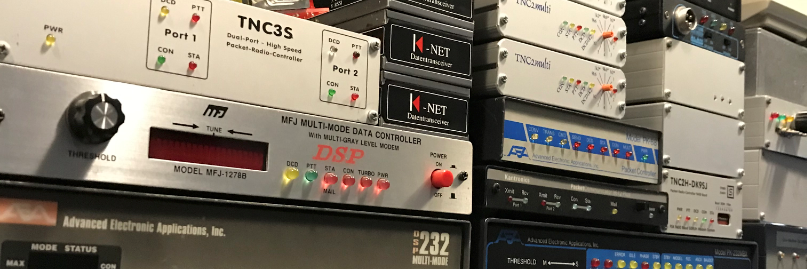In the previous post about Direwolf and jnos i use Direwolf-1.3 and does not know about the SERIALKISS port.
John WQ6N point it out to me… Tnx John WQ6N. Nice one.
Read the previous post.
So maybe I wrote that script for nothing. This is working pretty simple 🙂
In Direwolf 1.5-beta is it possible to use SERIALKISS to connect com to com.
I have try to use a PTY pair created with socat.
# Create pty pair socat -d -d -ly PTY,link=/dev/ttyq1 PTY,link=/dev/ptyq1 & sleep 2 # Start Direwolf direwolf -d kn -c /direwolf/direwolf.conf &> /var/log/direwolf.log >/dev/tty3 & sleep 2 Direwolf.conf SERIALKISS /dev/ttyq1 19200 # Jnos autoexec.nos attach asy ptyq1 - ax25 ax0 4096 256 19200 Fireup Jnos ./jnos -C -g2 -u3 -f nos.cfg -i
I use conspy to look at the output of Direwolf. apt-get install conspy
Use it just like this “conspy 3” The number 3 stands for the tty were Direwolf is running on /dev/tty3.
Hit the escape button a couple of times to exit.
Here is the output of Direwolf
>>> Data frame to KISS client application, port 0, total length = 82 000: c0 00 92 88 40 40 40 40 e0 9c 98 70 b4 b4 8a 60 ....@@@@...p...` 010: ae 92 88 8a 62 40 63 03 f0 43 6f 6e 6e 65 63 74 ....b@c..Connect 020: 20 4e 4c 36 5a 5a 45 20 66 6f 72 20 74 68 65 20 PD2LT-6 for the 030: 4a 4e 4f 53 20 43 6f 6e 76 65 72 73 20 28 6c 69 JNOS Convers (li 040: 6e 6b 65 64 20 77 69 74 68 20 6f 74 68 65 72 73 nked with others 050: 29 c0
Ok that is working quit well.
I start Direwolf with the option “-d kn” So you can look at the kiss communication between Direwolf and Jnos.
Some text out of the User-Guide.pdf.
“Up to 3 concurrent TCP KISS client applications are allowed at the same time.
You can raise this limit by increasing the value of MAX_NET_CLIENTS, in source file kissnet.c and recompiling.”
Whoooo thats nice up to 3 (and more) applications can connect to Direwolf on the KISSPORT.
And there is also the AGW and the SERIALKISS port. Men where do I start.
John WQ6N
John WQ6N has found something that is useful. He use a Legacy BSD pseudo pair.
There are no Legacy BSD pseudo pairs in Linux any more. But it is possible to create some.
/etc/default/grub: Change line from: GRUB_CMDLINE_LINUX="" to: GRUB_CMDLINE_LINUX="pty.legacy_count=10" (Where 10 is the number of pty legacy devices you require.) This created 10 ptypX/ttypX terminal pairs.
After editing the grub file run the command “update-grub” and reboot.
So now it`s time to set Direwolf and Jnos to use the pty Legacy devices.
The Direwolf SERIALKISS SERIALKISS /dev/ptyp0 19200 The associated JNOS2 attach line: attach asy ttyp0 - ax25 hfgw 4096 256 19200


